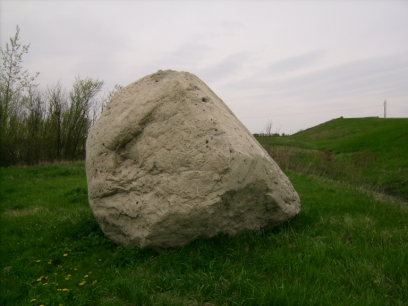
Glaciers form during climatic episodes when more snow accumulates during the winter than melts away during the summer; over time the snow thickens and under the pressure of its own weight is compressed into ice and begins to flow outward. During warm intervals, glacier ice melts and the glaciers recede (melt back). During cold intervals, more snow accumulates than melts and the glaciers advance. Rocks and soil frozen in the base of the glacier are dragged along. These materials can act like sandpaper to smooth the landscape over which the glacier passes. This abrasion can smooth the face of rocks and round out hills. It can also gouge out valleys. On some exposed rock surfaces you can find evidence of this glacial scouring in the form of glacial striations (parallel lines carved into the rock).
Like rivers, glaciers tend to follow the path of least resistance. The glaciers that flowed into the northern United States from Canada during the Ice Age followed the courses of former river valleys that were eroded into the least resistant rocks. The glaciers gouged out rock from the base and sides of these valleys creating the troughs occupied today by the Great Lakes.
When glaciers melt, they leave behind whatever they were carrying. This may consist of a mixture of rock debris and old soils, called till, material that was ground-up and deposited from the base of the glacier. Some of the most striking reminders that the landscape was once covered by glaciers are boulders and cobbles, called erratics, that dot the landscape. Unlike the rock you find in local quarries, these are exotic rocks. In Illinois, erratics are often granitic rocks like those you would find today hundreds of miles away in Canada.
Glacial meltwaters carried ground-up rock debris away from the glaciers. In the valleys of major meltwater channels, like the Mississippi and Illinois valleys, this debris settled out as layers of silt, sand, and gravel, called outwash. On dry, windy days, the finest particles of this outwash were blown across the landscape in glacial dust storms. These particles settled across the landscape to form a blanket of silt-size particles, called loess. Loess forms the basis of the young, rich soils of the northern plains of the United States.
Source: Illinois State Geological Survey
http://www.isgs.uiuc.edu/maps-data-pub/publications/geobits/geobit1.shtml
Around Illinois are boulders lying alone in the corner of a field, someone's yard, or as markers at historical sites. These boulders are glacial erratics. Many of them are colorful and glittering granites, banded gneisses, and other igneous and metamorphic rocks. They seem out of place in the rockless prairie of our state.
Where did erratics come from?
These exotic rocks came from Canada and the states north of us. The continental glaciers of the Great Ice Age scoured and scraped the land surface as they advanced, pushing up chunks of bedrock and grinding them against each other or along the ground surface as the rock-laden ice sheets pushed southward. Sometimes you can tell where the erratic originally came from by determining the kind of rock it is. A large boulder of granite, gneiss, or other igneous or metamorphic rock may have come from Canada. Some erratics containing flecks of copper were probably transported here from the "Copper Range" of the upper peninsula of Michigan. Large pieces of copper have been found in glacial deposits of central and northern Illinois. Light gray to white quartzite boulders with beautiful, rounded pebbles of red jasper came from Ontario, Canada. Purplish pieces of quartzite, some of them banded, probably originated in Wisconsin. Most interesting are the few large boulders of Canadian tillite. Glacial till is an unsorted and unlayered mixture of clay, sand, gravel, and boulders that vary widely in size and shape. Tillite is glacial till that was deposited by a glacier many millions of years older than the ones that invaded our state during the Great Ice Age. This glacial till has been around so long that it has hardened into a gray to greenish gray rock containing a mixture of grains of different sizes and scattered pebbles of various types and sizes.
A cubic yard of stone (27 cubic feet) weighs approximately 2.5 tons, estimate how heavy you think this boulder is.
To log this Earthcache:
1)Post a picture of yourself and GPSr with the Erratic in the background. You do not need to leave the roadway. Due to new guidelines the picture is optional but helps me verify your visit and is much appreciated.
2) Email me the answers to these questions within 3 days of your log: DO NOT POST ANSWERS IN YOUR LOG.
a)Measure or estimate height, width, and length.
b)Estimate weight of erratic.
c)tell me what type of rock is this?
If these requirements are not met your log will be deleted.
Cache placed by a member of CIGA

Link to CIGA Home Page